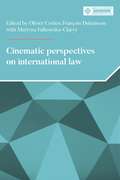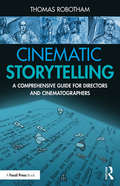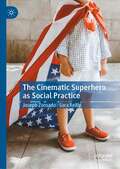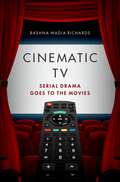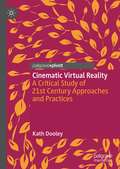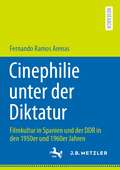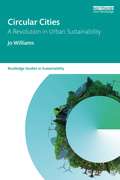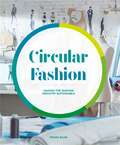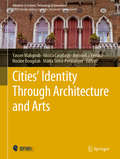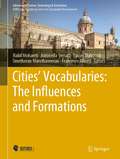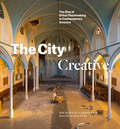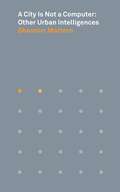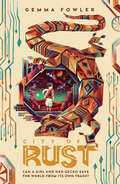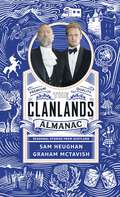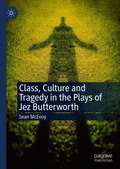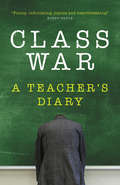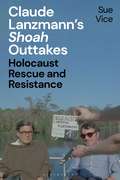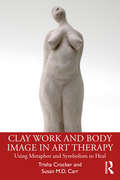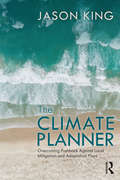- Table View
- List View
Cinematic perspectives on international law (Melland Schill Perspectives on International Law)
by Sufyan DroubiThe proposed volume consists of an edited collection within the new Melland Schill Guidebooks on International Law (MSGIL) series. In line with the MSGIL objective of inclusiveness, originality, perspectivism and critical thought, the book is the first of an intended series pertaining to perspectives related to the ways in which the arts influence the perception and attitude of the public towards international law, and the manner this affects the discipline, both in terms of its own development and in terms of its social legitimacy. The book contrasts the narratives of international law depicted in cinema and TV productions with the corresponding narratives advanced by legal scholars. It identifies a cognitive dissonance between them and ascertains its implications on general perceptions of international law.
Cinematic Storytelling: A Comprehensive Guide for Directors and Cinematographers
by Thomas RobothamThis book presents a new, story-based approach to cinematic coverage and storytelling in film and video. It breaks from the conventional idea that shots are the fundamental unit of filmmaking, instead exploring the specifics of determining coverage. Keyframes in patterns are introduced, delivering scripted material in a context-rich presentation that supports the storytelling. All the analysis, interpretation, and creative decision making is done first, with shots derived as the very last step. Scripted material is divided into six categories with associated patterns. Like cinematic building blocks, these can freely stack up and interconnect, supporting creativity and avoiding rigid formulas. This approach enables filmmakers to tap into the film "language" that audiences already understand and put it to practical use, helping the audience to feel the storytelling deeply. Dozens of film examples are provided throughout, plus conceptual and camera diagrams to contextualize the methods presented, and exercises are provided to reinforce concepts. Emphasis is placed on supporting performance and story meaning through a cinematic context. With all the concepts and decision-making options described and shown in examples, a scripted scene is analyzed and developed through an eight-step process, illustrated with storyboard, camera diagrams, and ultimately shot list descriptions. The book is ideal for filmmaking students interested in directing and cinematography, as well as aspiring and early-career filmmakers, cinematographers, and directors.
Cinematic Storytelling: A Comprehensive Guide for Directors and Cinematographers
by Thomas RobothamThis book presents a new, story-based approach to cinematic coverage and storytelling in film and video. It breaks from the conventional idea that shots are the fundamental unit of filmmaking, instead exploring the specifics of determining coverage. Keyframes in patterns are introduced, delivering scripted material in a context-rich presentation that supports the storytelling. All the analysis, interpretation, and creative decision making is done first, with shots derived as the very last step. Scripted material is divided into six categories with associated patterns. Like cinematic building blocks, these can freely stack up and interconnect, supporting creativity and avoiding rigid formulas. This approach enables filmmakers to tap into the film "language" that audiences already understand and put it to practical use, helping the audience to feel the storytelling deeply. Dozens of film examples are provided throughout, plus conceptual and camera diagrams to contextualize the methods presented, and exercises are provided to reinforce concepts. Emphasis is placed on supporting performance and story meaning through a cinematic context. With all the concepts and decision-making options described and shown in examples, a scripted scene is analyzed and developed through an eight-step process, illustrated with storyboard, camera diagrams, and ultimately shot list descriptions. The book is ideal for filmmaking students interested in directing and cinematography, as well as aspiring and early-career filmmakers, cinematographers, and directors.
The Cinematic Superhero as Social Practice
by Joseph Zornado Sara ReillyThis book analyzes the cinematic superhero as social practice. The study’s critical context brings together psychoanalysis and restorative and reflective nostalgia as a way of understanding the ideological function of superhero fantasy. It explores the origins of cinematic superhero fantasy from antecedents in myth and religion, to twentieth-century comic book, to the cinematic breakthrough with Superman (1978). The authors then focus on Spider-Man as reflective response to Superman’s restorative nostalgia, and read MCU’s overarching narrative from Iron Man to End Game in terms of the concurrent social, political, and environmental conditions as a world in crisis. Zornado and Reilly take up Wonder Woman and Black Panther as self-conscious attempts to reflect on gender and race in restorative superhero fantasy, and explore Christopher Nolan’s Dark Knight trilogy as a meditation on the need for authoritarian fascism. The book concludes with Logan, Wonder Woman 1984, and Amazon Prime’s The Boys as distinctly reflective fantasy narratives critical of the superhero fantasy phenomenon.
Cinematic TV: Serial Drama goes to the Movies
by Rashna Wadia RichardsFor decades after its invention, television was considered by many to be culturally deficient when compared to cinema, as analyses rooted in communication studies and the social sciences tended to focus primarily on television's negative impact on consumers. More recently, however, denigration has largely been replaced by serious critical consideration of what television represents in the post-network era. Once derided as a media wasteland, TV is now praised for its visual density and complexity. In the last two decades, media scholars have often suggested that television has become cinematic. Serial dramas, in particular, are acclaimed for their imitations of cinema's formally innovative and narratively challenging conventions. But what exactly does "cinematic TV" mean? In Cinematic TV, author Rashna Wadia Richards takes up this question comprehensively, arguing that TV dramas quote, copy, and appropriate (primarily) American cinema in multiple ways and toward multiple ends. Constructing an innovative theoretical framework by combining intertextuality and memory studies, Cinematic TV focuses on four modalities of intermedial borrowings: homage, evocation, genre, and parody. Through close readings of such exemplary shows as Stranger Things, Mad Men, Damages, and Dear White People, the book demonstrates how serial dramas reproduce and rework, undermine and idolize, and, in some cases, compete with and outdo cinema.
Cinematic Virtual Reality: A Critical Study of 21st Century Approaches and Practices
by Kath DooleyWith reference to traditional film theory and frameworks drawn from fields such as screenwriting studies and anthropology, this book explores the challenges and opportunities for both practitioners and viewers offered by the 360-degree storytelling form. It focuses on cinematic virtual reality (CVR), a format that involves immersive, high quality, live action or computer-generated imagery (CGI) that can be viewed through head mounted display (HMD) goggles or via online platforms such as YouTube. This format has surged in popularity in recent years due to the release of affordable high quality omnidirectional (360-degree) cameras and consumer grade HMDs. The book interrogates four key concepts for this emerging medium: immersion, presence, embodiment and proximity through an analysis of innovative case studies and with reference to practitioner interviews. In doing so, it highlights the specificity of the format and provides a critical account of practitioner approaches to the concept development, writing and realisation of short narrative CVR works. The book concludes with an account of the author’s practice-led research into the form, providing a valuable example of creative practice in the field of immersive media.
Cinephilie unter der Diktatur: Filmkultur in Spanien und der DDR in den 1950er und 1960er Jahren
by Fernando Ramos ArenasDiese Studie analysiert aus komparativer Perspektive die Filmkultur in Spanien und der DDR zur Zeit der Neuen Kinos. Fern von klassischen westeuropäischen Zentren nahmen in diesen Jahren Filmenthusiasten (Filmklubmitglieder, Filmkritiker und -studenten, Archiv- und Festivalbesucher...) an einer Erneuerungswelle transnationalen Charakters teil, die eine Reaktion auf die traditionellen, oft mit staatlichen Initiativen verwobenen Filmlandschaften postulierte. Trotz politischer Einschränkungen wurde die Filmkultur in beiden Diktaturen zu einem lebendigen Feld, das intensiv in die Vergangenheit schaute, sich international neu verortete und über Kino mit einer bis dahin nicht gekannten Intensität debattierte. Dieses Buch rekonstruiert diese Geschichte auf der Grundlage von Archivmaterialien unterschiedlicher Provenienz, Interviews mit Zeitzeugen sowie der Analyse der wichtigsten Publikationen der Zeit und bietet somit einen innovativen Beitrag, der unseren Blick auf die Geschichte der europäischen Filmkultur grundlegend erweitern soll.
Circular Cities: A Revolution in Urban Sustainability (Routledge Studies in Sustainability)
by Jo WilliamsWith cities striving to meet sustainable development goals, circular urban systems are gaining momentum, especially in Europe. This research-based book defines the circular city and circular development. It explains the shift in focus from a purely economic concept, which promotes circular business models in cities, to one that explores a new approach to urban development. This approach offers huge opportunities and addresses important sustainability issues: resource consumption and waste; climate change; the health of urban populations; social inequalities and the creation of sustainable urban economies. It examines the different approaches to circular development, drawing on research conducted in four European cities: Amsterdam, London, Paris and Stockholm. It explores different development pathways and levers for a circular urban transformation. It highlights the benefits of adopting a circular approach to development in cities, but acknowledges that these benefits are not shared equally across society. Finally, it focuses on the challenges to implementing circular development faced by urban actors. This ground-breaking book will be essential reading to scholars, students, practitioners and policymakers interested in the circular economy, urban sustainability, urban ecology, urban planning, urban regeneration, urban resilience, adaptive cities and regenerative cities.
Circular Cities: A Revolution in Urban Sustainability (Routledge Studies in Sustainability)
by Jo WilliamsWith cities striving to meet sustainable development goals, circular urban systems are gaining momentum, especially in Europe. This research-based book defines the circular city and circular development. It explains the shift in focus from a purely economic concept, which promotes circular business models in cities, to one that explores a new approach to urban development. This approach offers huge opportunities and addresses important sustainability issues: resource consumption and waste; climate change; the health of urban populations; social inequalities and the creation of sustainable urban economies. It examines the different approaches to circular development, drawing on research conducted in four European cities: Amsterdam, London, Paris and Stockholm. It explores different development pathways and levers for a circular urban transformation. It highlights the benefits of adopting a circular approach to development in cities, but acknowledges that these benefits are not shared equally across society. Finally, it focuses on the challenges to implementing circular development faced by urban actors. This ground-breaking book will be essential reading to scholars, students, practitioners and policymakers interested in the circular economy, urban sustainability, urban ecology, urban planning, urban regeneration, urban resilience, adaptive cities and regenerative cities.
Circular Fashion: Making the Fashion Industry Sustainable
by Peggy BlumCreating sustainable fashion has never been more important. Circular Fashion provides an accessible, practical, and holistic approach to this key topic for anyone studying fashion.This introductory text to sustainability in fashion includes best practice case studies and profiles of key companies such as Patagonia, Veja, Christopher Raeburn, and Stella McCartney. It begins with an overview of the fashion business, tackling the issues of the linear production model of make, use, dispose, before introducing the idea of the circular supply chain.Circular Fashion is the must-have book for fashion students, creatives and anyone passionate about sustainability and fashion.
Circulation and Control: Artistic Culture and Intellectual Property in the Nineteenth Century
by Marie-Stéphanie Delamaire And Will SlauterThe nineteenth century witnessed a series of revolutions in the production and circulation of images. From lithographs and engraved reproductions of paintings to daguerreotypes, stereoscopic views, and mass-produced sculptures, works of visual art became available in a wider range of media than ever before. But the circulation and reproduction of artworks also raised new questions about the legal rights of painters, sculptors, engravers, photographers, architects, collectors, publishers, and subjects of representation (such as sitters in paintings or photographs). Copyright and patent laws tussled with informal cultural norms and business strategies as individuals and groups attempted to exert some degree of control over these visual creations. With contributions by art historians, legal scholars, historians of publishing, and specialists of painting, photography, sculpture, and graphic arts, this rich collection of essays explores the relationship between intellectual property laws and the cultural, economic, and technological factors that transformed the pictorial landscape during the nineteenth century. This book will be valuable reading for historians of art and visual culture; legal scholars who work on the history of copyright and patent law; and literary scholars and historians who work in the field of book history. It will also resonate with anyone interested in current debates about the circulation and control of images in our digital age.
Cities' Identity Through Architecture and Arts: Proceedings Of The International Conference On Cities' Identity Through Architecture And Arts (citaa 2017), May 11-13, 2017, Cairo, Egypt (Advances in Science, Technology & Innovation)
by Yasser Mahgoub Nicola Cavalagli Antonella Versaci Hocine Bougdah Marta Serra-PermanyerThis book covers a broad range of topics relating to architecture and urban design, such as the conservation of cities’ culture and identity through design and planning processes, various ideologies and approaches to achieving more sustainable cities while retaining their identities, and strategies to help cities advertise themselves on the global market.Every city has its own unique identity, which is revealed through its physical and visual form. It is seen through the eyes of its inhabitants and visitors, and is where their collective memories are shaped. In turn, these factors affect tourism, education, culture & economic prosperity, in addition to other aspects, making a city’s identity one of its main assets.Cities’ identities are constructed and developed over time and are constantly evolving physically, culturally and sociologically. This book explains how architecture and the arts can embody the historical, cultural and economic characteristics of the city. It also demonstrates how cities’ memories play a vital role in preserving their physical and nonphysical heritage. Furthermore, it examines the transformation of cities and urban cultures, and investigates the various new approaches developed in contemporary arts and architecture.Given its scope, the book is a valuable resource for a variety of readers, including students, educators, researchers and practitioners in the fields of city planning, urban design, architecture and the arts.
Cities’ Vocabularies: The Influences and Formations (Advances in Science, Technology & Innovation)
by Nabil Mohareb Antonella Versaci Yasser Mahgoub Sreetheran Maruthaveeran Francesco AlbertiThis book discusses several topics regarding different vocabularies, such as sacred architecture, heritage buildings, open spaces, landmarks, and street escapes, all of which have a direct influence on the city form. The city form is also affected by the indirect impact of the citizens themselves, for example their culture, which in turn depends on the arts, as can be seen and embodied in morals, paintings, media, digital art, and sculpture. The book also examines the fundamental elements that are responsible for the identity of the city. Presenting case studies that demonstrate the how implementing the concept of the responsibility of architecture and arts affects the development of our cities, the book offers a new approach that is based on the available features of a city and explores how planners and decision-makers can use these features to address the myriad problems that our cities are facing.
The City Creative: The Rise of Urban Placemaking in Contemporary America
by Michael H. Carriere David SchalliolIn the wake of the Great Recession, American cities from Philadelphia to San Diego saw an upsurge in hyperlocal placemaking—small-scale interventions aimed at encouraging greater equity and community engagement in growth and renewal. But the projects that were the most successful at achieving these lofty ambitions weren’t usually established by politicians, urban planners, or real estate developers; they were initiated by community activists, artists, and neighbors. In order to figure out why, The City Creative mounts a comprehensive study of placemaking in urban America, tracing its intellectual history and contrasting it with the efforts of people making positive change in their communities today. Spanning the 1950s to the post-recession 2010s, The City Creative highlights the roles of such prominent individuals and organizations as Jane Jacobs, Christopher Alexander, Richard Sennett, Project for Public Spaces, and the National Endowment for the Arts in the development of urban placemaking, both in the abstract and on the ground. But that’s only half the story. Bringing the narrative to the present, Michael H. Carriere and David Schalliol also detail placemaking interventions at more than 200 sites in more than 40 cities, combining archival research, interviews, participant observation, and Schalliol’s powerful documentary photography. Carriere and Schalliol find that while these formal and informal placemaking interventions can bridge local community development and regional economic plans, more often than not, they push the boundaries of mainstream placemaking. Rather than simply stressing sociability or market-driven economic development, these initiatives offer an alternative model of community-led progress with the potential to redistribute valuable resources while producing tangible and intangible benefits for their communities. The City Creative provides a kaleidoscopic overview of how these initiatives grow, and sometimes collapse, illustrating the centrality of placemaking in the evolution of the American city and how it can be reoriented to meet demands for a more equitable future.
The City Creative: The Rise of Urban Placemaking in Contemporary America
by Michael H. Carriere David SchalliolIn the wake of the Great Recession, American cities from Philadelphia to San Diego saw an upsurge in hyperlocal placemaking—small-scale interventions aimed at encouraging greater equity and community engagement in growth and renewal. But the projects that were the most successful at achieving these lofty ambitions weren’t usually established by politicians, urban planners, or real estate developers; they were initiated by community activists, artists, and neighbors. In order to figure out why, The City Creative mounts a comprehensive study of placemaking in urban America, tracing its intellectual history and contrasting it with the efforts of people making positive change in their communities today. Spanning the 1950s to the post-recession 2010s, The City Creative highlights the roles of such prominent individuals and organizations as Jane Jacobs, Christopher Alexander, Richard Sennett, Project for Public Spaces, and the National Endowment for the Arts in the development of urban placemaking, both in the abstract and on the ground. But that’s only half the story. Bringing the narrative to the present, Michael H. Carriere and David Schalliol also detail placemaking interventions at more than 200 sites in more than 40 cities, combining archival research, interviews, participant observation, and Schalliol’s powerful documentary photography. Carriere and Schalliol find that while these formal and informal placemaking interventions can bridge local community development and regional economic plans, more often than not, they push the boundaries of mainstream placemaking. Rather than simply stressing sociability or market-driven economic development, these initiatives offer an alternative model of community-led progress with the potential to redistribute valuable resources while producing tangible and intangible benefits for their communities. The City Creative provides a kaleidoscopic overview of how these initiatives grow, and sometimes collapse, illustrating the centrality of placemaking in the evolution of the American city and how it can be reoriented to meet demands for a more equitable future.
A City Is Not a Computer: Other Urban Intelligences (Places Books #2)
by Shannon MatternA bold reassessment of "smart cities" that reveals what is lost when we conceive of our urban spaces as computersComputational models of urbanism—smart cities that use data-driven planning and algorithmic administration—promise to deliver new urban efficiencies and conveniences. Yet these models limit our understanding of what we can know about a city. A City Is Not a Computer reveals how cities encompass myriad forms of local and indigenous intelligences and knowledge institutions, arguing that these resources are a vital supplement and corrective to increasingly prevalent algorithmic models.Shannon Mattern begins by examining the ethical and ontological implications of urban technologies and computational models, discussing how they shape and in many cases profoundly limit our engagement with cities. She looks at the methods and underlying assumptions of data-driven urbanism, and demonstrates how the "city-as-computer" metaphor, which undergirds much of today's urban policy and design, reduces place-based knowledge to information processing. Mattern then imagines how we might sustain institutions and infrastructures that constitute more diverse, open, inclusive urban forms. She shows how the public library functions as a steward of urban intelligence, and describes the scales of upkeep needed to sustain a city's many moving parts, from spinning hard drives to bridge repairs.Incorporating insights from urban studies, data science, and media and information studies, A City Is Not a Computer offers a visionary new approach to urban planning and design.
A City Is Not a Computer: Other Urban Intelligences (Places Books #2)
by Shannon MatternA bold reassessment of "smart cities" that reveals what is lost when we conceive of our urban spaces as computersComputational models of urbanism—smart cities that use data-driven planning and algorithmic administration—promise to deliver new urban efficiencies and conveniences. Yet these models limit our understanding of what we can know about a city. A City Is Not a Computer reveals how cities encompass myriad forms of local and indigenous intelligences and knowledge institutions, arguing that these resources are a vital supplement and corrective to increasingly prevalent algorithmic models.Shannon Mattern begins by examining the ethical and ontological implications of urban technologies and computational models, discussing how they shape and in many cases profoundly limit our engagement with cities. She looks at the methods and underlying assumptions of data-driven urbanism, and demonstrates how the "city-as-computer" metaphor, which undergirds much of today's urban policy and design, reduces place-based knowledge to information processing. Mattern then imagines how we might sustain institutions and infrastructures that constitute more diverse, open, inclusive urban forms. She shows how the public library functions as a steward of urban intelligence, and describes the scales of upkeep needed to sustain a city's many moving parts, from spinning hard drives to bridge repairs.Incorporating insights from urban studies, data science, and media and information studies, A City Is Not a Computer offers a visionary new approach to urban planning and design.
City Of Rust (ebook)
by Gemma FowlerRailey dreams of winning the drone races with her bio-robotic gecko friend, Atti. But when a bounty hunter crashes their biggest race yet, the pair are forced to flee to the feared Junker clans who mine the rubbish orbiting the Earth. Rescued by a couple of Junker kids, they discover a danger bigger than anything they’d imagined – but can three kids, a gecko and an ancient computer save the world against the huge trash bomb (and its power-crazed creator) threatening to destroy the world? In this fun, original and thrilling middle-grade debut from Gemma Fowler, think Star Wars meets Wall-E in an ecologically-themed mystery adventure – sci-fi for a new generation!
The Clanlands Almanac: Seasonal Stories from Scotland
by Sam Heughan Graham McTavishA seasonal meander through the wilds of Scotland.'If Clanlands was a gentle road trip through Scotland, this almanac is a top down, pedal to the metal up and down odyssey through the many byways of a Scottish year. An invitation to anyone who picks up the book to join us on a crazy camper van exploration over 12 glorious, whisky fuelled months. Mountains, battles, famous (and infamous) Scots, the alarming competitiveness of Men in Kilts, clans, feuds, flora, fauna, with a healthy sprinkling of embarrassing personal reminiscences thrown in. Much is explored, all is shared. It is a camper van cornucopia of all things Alba'.From First Footing to Samhain, Fringe Festival follies to whisky lore, Sam & Graham guide readers through a year of Scottish legends, traditions, historical and contemporary events, sharing personal stories and tips as only these two chalk-and-cheese friends can.As entertaining as it is practical, The Clanlands Almanac is a light-hearted education in Scottish history and culture, told through the eyes of two passionate Scotsmen. The perfect escapist guide, The Clanlands Almanac is intended as a starting point for your own Scottish discoveries.
Class, Culture and Tragedy in the Plays of Jez Butterworth
by Sean McEvoyJez Butterworth is undoubtedly one of the most popular and commercially successful playwrights to have emerged in Britain in the early twenty-first century. This book, only the second so far to have been written on him, argues that the power of his most acclaimed work comes from a reinvigoration of traditional forms of tragedy expressed in a theatricalized working-class language. Butterworth’s most developed tragedies invoke myth and legend as a figurative resistance to the flat and crushing instrumentalism of contemporary British political and economic culture. In doing so they summon older, resonant narratives which are both popular and high-cultural in order to address present cultural crises in a language and in a form which possess wide appeal. Tracing the development of Butterworth’s work chronologically from Mojo (1995) to The Ferryman (2017), each chapter offers detailed critical readings of a single play, exploring how myth and legend become significant in a variety of ways to Butterworth’s presentation of cultural and personal crisis.
Class War: A Teacher's Diary
by AnonymousA scrabrously funny look inside the classroom from a teacher who has had enough of a system that is on its knees and with morale at rock-bottom. Intoning his mantra of ‘July, July, July!’ the anonymous author – still a serving secondary school teacher – ranges over his teaching career from his student practice to the present day: from colleagues praying for a minor heart attacks so they can get six months paid leave and a foot in the door of early retirement, to the increasing alienation of young people and the alarming rise in mental health issues and self-harming.Reasoning that it’s either laugh or cry, this teacher does both. Heartfelt and seriously funny, Class War is a diary account written as therapy, and an inside look like no other at the pressure-cooker that is a secondary school.Hilarious, heart-breaking and impassioned, this is a book about the value and importance of good teachers and good schools in a world where lack of resources and ever increasing demands place intolerable strains on them, Class War is a heartfelt portrait of the profession of teaching and a state education system where no one should be left behind but too many are.
Claude Lanzmann’s 'Shoah' Outtakes: Holocaust Rescue and Resistance
by Sue ViceAs we approach the end of the 'era of the witness', given the passing on of the generation of Holocaust survivors, Claude Lanzmann's archive of 220 hours of footage excluded from his ground-breaking documentary Shoah (1985) offers a remarkable opportunity to encounter previously unseen interviews with survivors and other witnesses, recorded in the late 1970s. Although the archive is all available freely to view online and includes extra footage of those who appear in Shoah, this book focuses on the interviews from which no extracts appear in the finished film or in any subsequent release. The material analysed features interviews with such significant figures as the former partisan Abba Kovner, wartime activist Hansi Brand, Kovno Ghetto leader Leib Garfunkel, rescuer Tadeusz Pankiewicz and members of Roosevelt's War Refugee Board, and focuses throughout on the efforts at rescue and resistance by those within and outside occupied Europe. Sue Vice contends that watching and analysing this wholly excluded footage gives us new insights into the making of Shoah through what was left out. Moreover, she reveals that the near-impossibility of rescue and often suicidal implications of resistance emerge through these excluded interviews as inextricable from the process of genocide. She concludes by arguing that the outtakes show the potential for new filmic forms envisaged on Lanzmann's part in order to represent the crucial topics of attempted Holocaust rescue and resistance.
Clay Work and Body Image in Art Therapy: Using Metaphor and Symbolism to Heal
by Trisha Crocker Susan M.D. CarrClay Work and Body Image in Art Therapy provides an important addition to resources available in the field of clay work and art therapy, highlighting the unique sensory aspects of the medium and its ability to provide a therapeutic resource for women who experience body image issues. Chapters offer a comprehensive distillation of current knowledge in the field of body image, clay work, neuroscience, and art therapy, building a theoretical framework around personal narratives. Case studies examine the benefits of exploring body image through clay work within art therapy practice, providing a positive and contained way to find personal acceptance and featuring photographs of clay body image sculptures created by research participants that highlight their individual stories and experiences. As well as offering both clinical and practical implications, the text provides a full protocol for the research and evaluation methods carried out, enabling further replication of the intervention and research methods by other therapists. This book highlights clay work as a significant resource for art therapists, arts in health practitioners, and counsellors, providing an emotive yet contained approach to the development of personal body image acceptance and self-compassion.
Clay Work and Body Image in Art Therapy: Using Metaphor and Symbolism to Heal
by Trisha Crocker Susan M.D. CarrClay Work and Body Image in Art Therapy provides an important addition to resources available in the field of clay work and art therapy, highlighting the unique sensory aspects of the medium and its ability to provide a therapeutic resource for women who experience body image issues. Chapters offer a comprehensive distillation of current knowledge in the field of body image, clay work, neuroscience, and art therapy, building a theoretical framework around personal narratives. Case studies examine the benefits of exploring body image through clay work within art therapy practice, providing a positive and contained way to find personal acceptance and featuring photographs of clay body image sculptures created by research participants that highlight their individual stories and experiences. As well as offering both clinical and practical implications, the text provides a full protocol for the research and evaluation methods carried out, enabling further replication of the intervention and research methods by other therapists. This book highlights clay work as a significant resource for art therapists, arts in health practitioners, and counsellors, providing an emotive yet contained approach to the development of personal body image acceptance and self-compassion.
The Climate Planner: Overcoming Pushback Against Local Mitigation and Adaptation Plans
by Jason KingThe Climate Planner is about overcoming the objections to climate change mitigation and adaption that urban planners face at a local level. It shows how to draft climate plans that encounter less resistance because they involve the public, stakeholders, and decisionmakers in a way that builds trust, creates consensus, and leads to implementation. Although focused on the local level, this book discusses climate basics such as carbon dioxide levels in the atmosphere, the Intergovernmental Panel on Climate Change, the Paris Agreement of 2015, worldwide energy generation forecasts, and other items of global concern in order to familiarize urban planners and citizen planners with key concepts that they will need to know in order to be able to host climate conversations at the local level. The many case studies from around the United States of America show how communities have encountered pushback and bridged the implementation gap, the gap between plan and reality, thanks to a commitment to substantive public engagement. The book is written for urban planners, local activists, journalists, elected or appointed representatives, and the average citizen worried about climate breakdown and interested in working to reshape the built environment.
